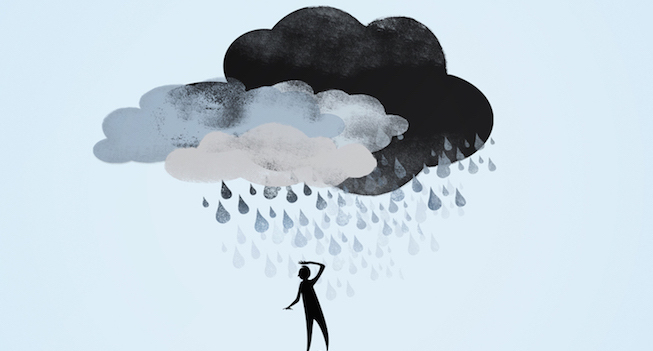It is widely believed that mental illnesses such as depression and anxiety only occur in women. However this is not the case. In this blog, PhD students Chris and Katie talk through the gendered stereotypes around mental illness and go through the process step by step, from symptoms to diagnosis.
Anxiety and depressive disorders are more commonly diagnosed and treated in women than in men (1). Such statistics may reinforce gendered stereotypes, that view women as emotionally weaker than men, and myths such as “depression and anxiety only affect women”. Historically, men were expected not to show emotions for fear of being seen as weak and so it’s possible this is the reason behind these stereotypes. However, this attitude is simply not true. Research studies examining the whole population have found that these disorders are common in both women and men. Whilst it is important to reduce stigma and increase help-seeking behaviours for everyone, this is particularly critical for men who are experiencing anxiety and/or depression. Unfortunately, suicide remains the most common cause of death in young men (2), which may often be due to unrecognised or untreated depression or anxiety. There are several complex reasons why these disorders are less visible in men. In this blog post, we focus on three interrelated barriers to diagnosis and treatment: unrecognised symptoms, help-seeking (or lack of), and stigma.
“Disorders are common in both women and men.”
Symptoms → Diagnosis
Anxiety and depressive disorders are most commonly characterised by persistent sadness, worry and loss of enjoyment, that are experienced at a level which disrupts daily life. However, as described in our previous blog post, there are many combinations of symptoms that indicate that a person is depressed. Research suggests that different combinations of depression symptoms are sex-specific (3). For example, men are more likely to present with aggression, alcohol/substance abuse, and risk-taking (4,5), and while these are not the “core” symptoms of depression, they are strong behavioural indicators. On one study that chose to include these symptoms as diagnostic criteria, rates of depression were comparable between the sexes (5). It has also been shown empirically that men are less able to identify depression in another person and moreover, this effect was most pronounced when the other person was also a man(6). As such, it is important that medical professionals consider depression even when it is not the primary concern of the patient, especially in men. This leads to our next point, differences in help-seeking.
Symptoms → Help-seeking → Diagnosis
A number of studies show that only a fraction of all those with anxiety/depression actually receive a diagnosis (7–10). Within the UK, individuals who are White British, female, or middle-aged were more likely to receive treatment than those who were not (11). Upcoming work from our group shows that men with anxiety/depression are ~30% less likely to have reported their symptoms to their doctor, when compared to women. As noted above, men may be less able to recognise their symptoms in the first instance. It is important to better recognise the signs and symptoms in oneself and in friends, family and colleagues to ensure that individuals seek help when they need it and are able to describe their symptoms accurately. We also know that men are more likely than women to self-medicate with alcohol and/or drugs in response to their symptoms. It is likely that the disparities in help-seeking and self-medication between men and women reflect differences in coping mechanisms and stigma towards mental health.
“Men may be less able to recognise their symptoms in the first instance”
Stigma → Help-seeking
Mental health stigma is pervasive, however, it has been suggested that the effects might be more pronounced in men, due to perceived societal pressures and gender stereotypes. For example, the idea that men are expected to be masculine, unemotional and invulnerable and that seeking help from friends, family, or a professional is seen as a sign of weakness(12). The myth that depression and anxiety only affect women enforces the social stigma that men should “man up”, that they should be tough and unemotional. Efforts are needed to change attitudes towards emotional symptoms and help-seeking to reduce stigma, improve mental health literacy and subsequently reduce the burden of untreated depression.
Both men and women commonly experience mental health problems, including anxiety and depressive disorders. The observed difference in diagnosis and treatment between men and women is likely due to sex differences in both the specific sympoms experienced, and help-seeking behaviour. Stigma is likely to exacerbate these differences and is a key target for improving both treatment outcomes, and our understanding of mental health in the population. This is why encouraging all individuals to seek help from a doctor when experiencing mental health symptoms, and taking part in research to learn more about individual experiences, is so important.

source: https://digest.bps.org.uk/2019/04/23/are-female-and-male-brains-fundamentally-different-an-expert-pours-cold-water-on-recent-claims-that-a-brain-scan-study-of-foetuses-proves-they-are/
References:
- Whiteford, H. A. et al. Global burden of disease attributable to mental and substance use disorders: findings from the Global Burden of Disease Study 2010. Lancet382, 1575–1586 (2013).
- Chang, Q., Yip, P. S. F. & Chen, Y.-Y. Gender inequality and suicide gender ratios in the world. J. Affect. Disord. 243, 297–304 (2019).
- Fried, E. I., Nesse, R. M., Zivin, K., Guille, C. & Sen, S. Depression is more than the sum score of its parts: individual DSM symptoms have different risk factors. Psychol. Med. 44, 2067–2076 (2014).
- Rice, S. M. et al. Longitudinal sex differences of externalising and internalising depression symptom trajectories: Implications for assessment of depression in men from an online study. Int. J. Soc. Psychiatry 61, 236–240 (2015).
- Martin, L. A., Neighbors, H. W. & Griffith, D. M. The experience of symptoms of depression in men vs women: analysis of the National Comorbidity Survey Replication. JAMA Psychiatry 70, 1100–1106 (2013).
- Swami, V. Mental health literacy of depression: gender differences and attitudinal antecedents in a representative British sample. PLoS One 7, e49779 (2012).
- Chisholm, D. et al. Scaling-up treatment of depression and anxiety: a global return on investment analysis. Lancet Psychiatry 3, 415–424 (2016).
- Thornicroft, G. Stigma and discrimination limit access to mental health care. Epidemiol. Psichiatr. Soc. 17, 14–19 (2008).
- Thornicroft, G. et al. Undertreatment of people with major depressive disorder in 21 countries. Br. J. Psychiatry 210, 119–124 (2017).
- Williams, S. Z., Chung, G. S. & Muennig, P. A. Undiagnosed depression: A community diagnosis. SSM Popul Health 3, 633–638 (2017).
- McManus, S. et al. Mental health and well-being in England: Adult Psychiatric Morbidity Survey 2014. NHS Digital (2016).
- 12. Sagar-Ouriaghli, I., Godfrey, E., Bridge, L., Meade, L. & Brown, J. S. L. Improving Mental Health Service Utilization Among Men: A Systematic Review and Synthesis of Behavior Change Techniques Within Interventions Targeting Help-Seeking. Am. J. Mens. Health 13, 1557988319857009 (2019).



